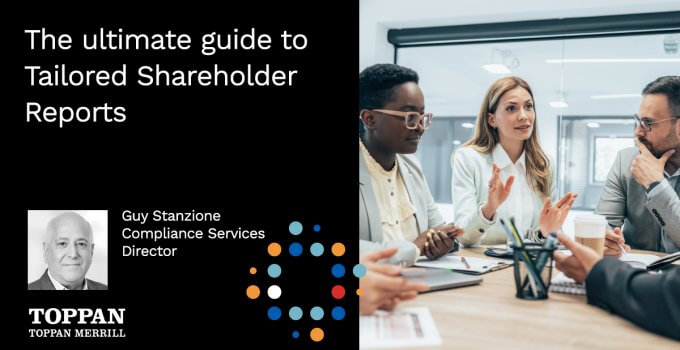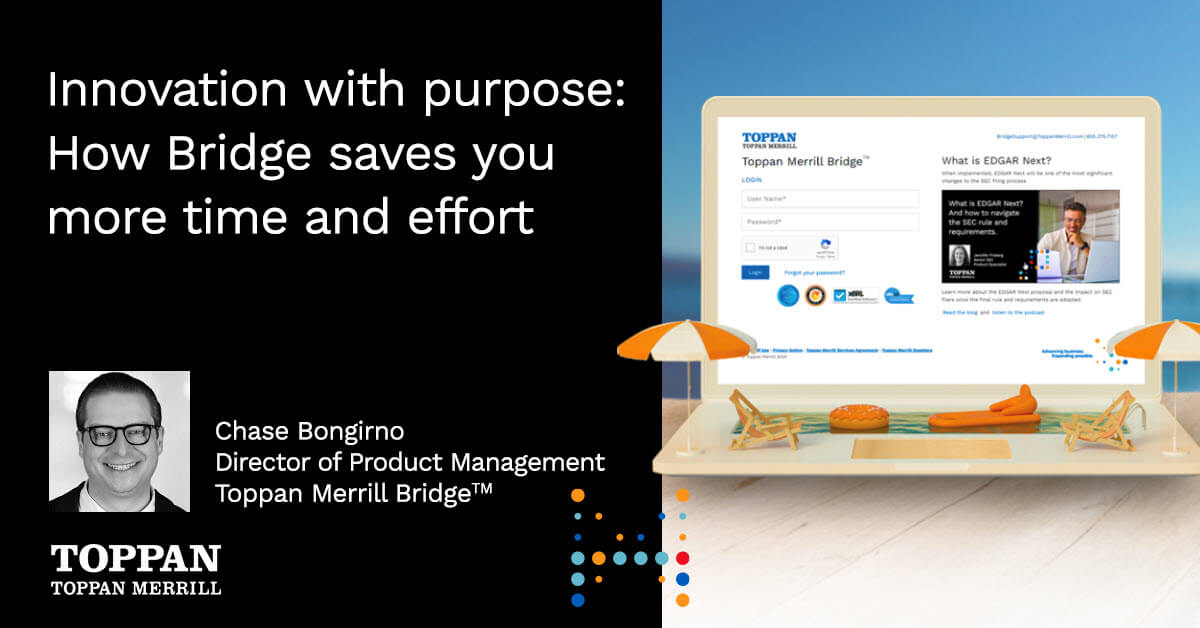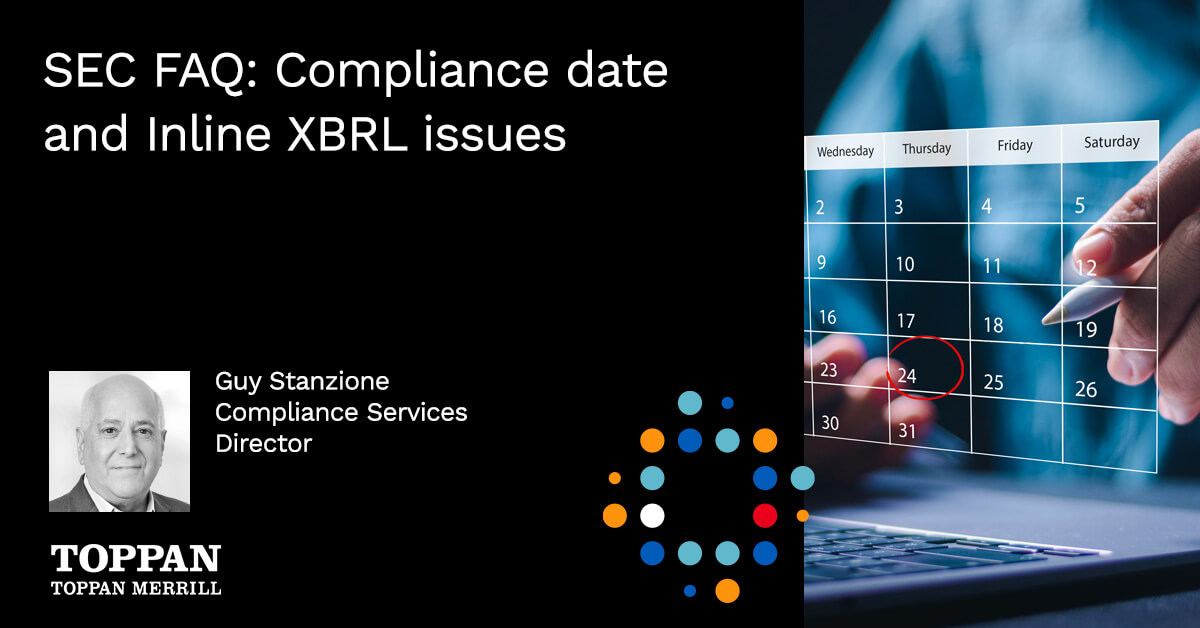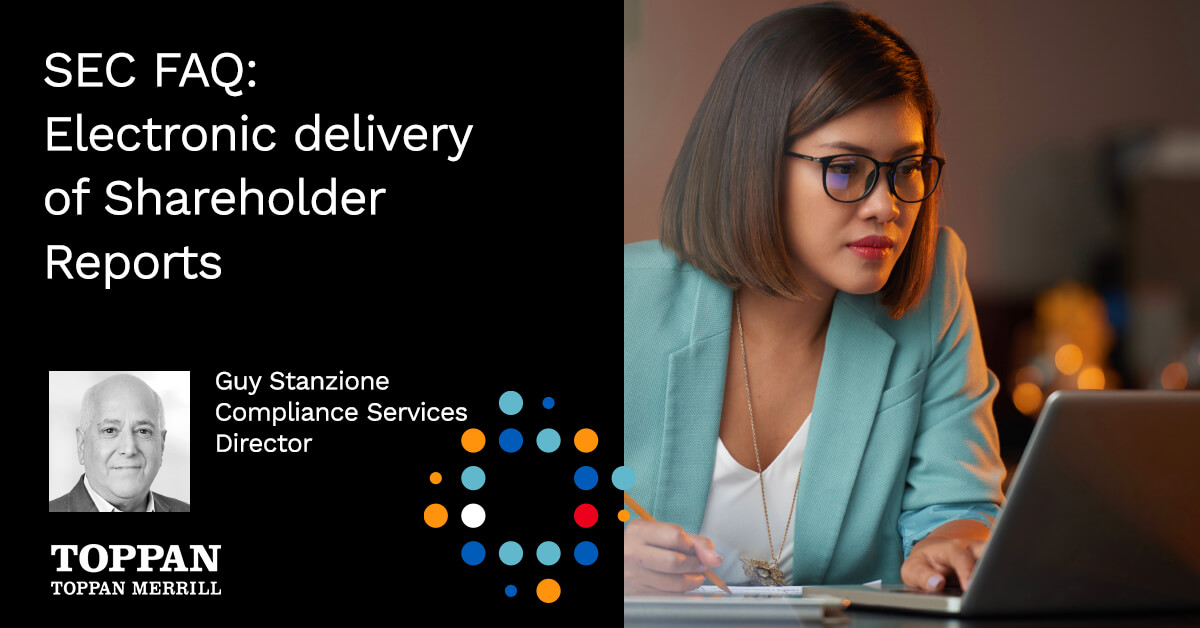Quick Links:
- What is the SEC’s new tailored shareholder report rule?
- Why the SEC made changes to tailored shareholder reports
- Preparing for SEC compliance
- 9 critical challenges to be tailored shareholder report ready
- 6 things you need to know about tailored shareholder reporting
- How Toppan Merrill can help
What is the SEC’s new Tailored Shareholder Report (TSR) rule?
In January 2023, the U.S. Securities and Exchange Commission (SEC) finalized new rules and amendments related to how mutual fund and Exchange-Traded Fund (ETF) providers file and deliver annual and semi-annual reports. Shareholder reports have long been required for mutual fund and ETF providers. The new requirement makes significant content presentation changes and calls for the annual and semi-annual reports to be tailored by fund share class, in a concise and visually engaging format.
Although looking more like an actual Fact Sheet than a financial report, much of the required content for the TSR already exists. The new rule introduces workflow changes for how content is “mapped” to a prescribed location in the shareholder report. Identifying existing content and incorporating new content within the report has been part of implementation planning for the past year. Applying the new iXBRL guidelines, the required content of the TSR will be tagged using the Open-End Fund (OEF) taxonomy.
These changes are a focused effort to furnish investors concise information that can be used to understand performance and monitor their investments. TSR’s must also include a visual presentation and definition of the appropriate broad-based securities market index.
To ensure compliance and focus on salient facts, non-prescriptive information may not be included in the TSR. The additional detailed fund disclosure will be filed as Items 7-11 on Form N-CSR and will be required to be available online and by written request. Beginning July 24, 2024, TSR’s must be mailed to shareholders within 60 days of the period end with mutual fund and ETF providers no longer able to rely on online distribution of the reports.
The SEC also changed how fee information is presented in investment company advertisements. For this change, investment and business development companies are required to have up-to-date transparent information about performance and investment costs in all advertising.
Why the SEC made changes to shareholder reports
SEC chair, Gary Gensler, explained the reasons for the changes in his October 26, 2022 press release, “Shareholder reports are amongst the most important documents that fund investors receive. These reports, however, often are more than 100 pages in length. As a result, a retail investor looking to understand the performance, fees and other operations of a mutual fund or exchange-traded fund may need to sift through extensive financial information. Today’s final rules will require fund companies to share a concise set of materials to the heart of the matter. Further, today’s final rules are designed to promote transparent and balanced presentations of fees and expenses in investment company advertisements.”
Preparing for SEC compliance
In brief, the new rule requires TSR’s to be concise and include iXBRL tagging. In addition, shareholder reports must be created at the share class level and will feature variable information related to each share class.
9 critical challenges to be Tailored Shareholder Report ready
1. Mapping data/content to tailored shareholder report output
The biggest challenge for fund complexes will be to gather and assemble the required tailored shareholder report data and content from multiple sources which exist inside and outside of their company.
Choosing the right platform to dynamically map data for each section to utilize the functional benefits of shared and variable content will streamline workflow and minimize workload.
2. Managing the three-level content challenge
We often discuss the effective management of multiple levels of shared, static and variable content as the three-level content challenge.
- Shared content across all funds within a fund complex
- Shared and variable content within a fund
- Shared and variable content at the share-class level
A purpose-built tailored shareholder reporting platform designed to manage content at these levels will result in operational efficiencies and compliance accuracy at the critical steps of document creation, investor delivery, web hosting and SEC filing.
3. Creating automated charts and graphics to meet the SEC’s new tailored shareholder report rule
The SEC created tailored shareholder report guidelines to ensure shareholders could easily understand fund performance and other pertinent information in a summary format. The creation of visually engaging reports used to support a fund complex brand, while utilizing automation, is one of their primary challenges.
To support document creation efficiencies, tailored shareholder reports should be created using a publishing platform that automates the creation of charts and graphs directly from data sources, to minimize manual intervention and errors.
4. Managing the complexities of TSR printing and distribution at the share-class level
Although the record keeping of investments is typically at the share-class level, the increased number of shareholder reports distributed due to TSR requirements compounds the complexity of accurate document delivery and meeting householding requirements.
Provider selection for this challenge is the most critical decision in the entire TSR print production lifecycle. It is essential to find an end-to-end solution dedicated to ensuring precise delivery of the correct TSR to individual shareholders.
Fund complexes should choose a provider with automated “direct to print” technology to produce share-class versions with flexible press options for short and long-runs. The provider must utilize digital and offset printing, configured to meet rules and business logic, tailored to maximize efficiency, deadline compliance and cost minimization.
5. Managing eDelivery at the share-class level to support investors
Much like print, effectively managing the electronic delivery of share-class specific tailored shareholder reports is essential to meeting the delivery preferences of individual shareholders.
Fund complexes should select an eDelivery platform that provides access to investor specific microsites for each required document. The platform should be document agnostic and based on investor delivery preference, allowing the flexibility for an investor to receive certain documents electronically, while others in paper format.
6. Ensuring tailored shareholder reports are website hosted to meet the SEC’s layered disclosure framework
Fund complexes should choose a provider who’s solution delivers the automated creation, assembly, and separation of the TSRs from the additional web content contained in the N-CSR. This requires integrated technology that automates the extraction of the required disclosure in Items 7 to 11 from the N-CSR, while content is managed in a single source of truth.
The SEC has introduced a layered disclosure approach, much like the one applied to the Mutual Fund Summary Prospectus (Rule 498) framework. With the SEC requiring a print default model, investors must be able to access the required fund information online within a minimum number of mouse-clicks, similar to accessing Summary Prospectuses. The annual and semi-annual TSR for every share class, along with more detailed disclosure from the N-CSR, must be displayed on a website and accessible in a single click from a landing page. In addition, as a continuation of the Rule 30e-3, funds must continue to host First and Third Quarter Holdings, providing a one-year look back at fund performance.
7. Meeting the EDGAR HTML and iXBRL requirements with the changes to Form N-CSR
In a significant change to Form N-CSR, the SEC created new Items 7 to 11 specific to Open-End funds. Financial statements, Schedules of Investment and Financial Highlights, previously included in the shareholder report are now required as Items 7a and 7b in the Form N-CSR, with some crossover of content between the TSR and N-CSR.
It came as no surprise when the SEC added the iXBRL requirement to the final tailored shareholder report rule. To comply with the XBRL requirement, Open-End funds must tag the TSRs using the anticipated Open-End Fund (OEF) taxonomy. In addition to the TSR XBRL requirement there will also be a transition period for fund prospectuses to begin using the new taxonomy.
To support the iXBRL requirement, the platform used to generate tailored shareholder reports must be able to support xHTML, the HTML version required to file XBRL. Using a platform that transforms HTML to xHTML is essential to meet validation requirements and compliance deadlines, while maintaining content accuracy and integrity.
8. Selecting a platform to support the EDGAR xHTML assembly and filing
With the additional disclosure of Items 7 to 11 required in Form N-CSR and the need to transform HTML to xHTML, fund complexes must ensure their provider’s platform automates the assembly of their N-CSR and validates the SEC submission prior to filing.
In compliance with the website hosting requirement, the platform needs to be able to customize the output to dynamically extract Items 7 to 11.
9. Ensuring ADA compliance and incorporating ADA accessibility
SEC regulations do not require electronic materials to be ADA-accessible and do not oversee The Americans with Disabilities Act (ADA) compliance; the frequency of litigation related to non-compliance has increased over the last few years.
ADA compliance includes a variety of accessibility standards such as the inclusion of a text reader, employment of color contrast and color use standards. All links, images, and videos have alternative text to define the asset for the visually impaired.
6 things you need to know about tailored shareholder reporting
1. Brevity:
These changes have been made to streamline and modernize shareholder reports, with the ultimate goal of making them accessible to investors at all levels of proficiency. For example, in 2009, the SEC introduced Summary Prospectuses for mutual funds, streamlining and simplifying Prospectus disclosure.
2. Sections to include:
- The beginning of the report or cover page should state the fund’s name, type of report, the ticker symbol or class, the markets the fund is traded on, required legends and brief instructions on how to find additional information.
- A simplified expense example in a $10,000 investment format and include a column for expenses as a percent of the shareholder’s investment. The table should only report the expenses for the past year or six months, depending on the type of report being filed.
- The expense example replaces the preamble and two-table expense example. The table also does not need to include total fund returns or transaction costs. However, some additional information, like extraordinary expenses, can be included in the footnotes.
- The Management’s Discussion of Fund Performance Section will need to be concise. It should only highlight key points about the investing narrative and include past performance and benchmark information, like the historical 10-year performance according to the class of investor for which the report has been prepared.
- The Fund statistics section must now clearly present the types of investments the fund has made and how that relates to the fund’s objective. In addition, funds can now report holdings in terms of their total exposure and include a list of the top 10 holdings and metrics.
- Aside from reformatting the section to be as concise as possible, no significant changes were made to the material Fund Changes Section.
- A new Availability of Additional Information Section must now be included. This section will highlight in detail where shareholders can find different types of information, including the prospectus, holdings and proxy voting information.
3. Delivery:
One tailored shareholder report per share class will be delivered to each household. An explanation of this may be included in the report. In addition, reports are to be delivered in paper form by mail unless the account owner has previously consented to electronic delivery.
Funds must also electronically file these reports with the SEC, under form type N-CSR, along with additional information.
4. XBRL:
The SEC has been continuously integrating the use of the XBRL language in reporting.
Those responsible for preparing reports should ensure the software they use is equipped for the change. For example, some SaaS solutions might not allow you to quickly set variable fields, leaving you to manually create individual reports for each class. This will be time-consuming and will make the process vulnerable to copy-and-paste errors.
5. Advertising amendments:
Investment company advertisements must now include the maximum amount of any sales load, or other nonrecurring fee, and the total annual expense without a fee waiver or reimbursement arrangement, presented prominently as additional fees. This change addresses concerns about advertising that might lead investors to think that fees are lower than they are.
6. Client communications:
Aside from the necessary change management and due diligence to ensure that reports comply, clients may wonder why they are receiving a four-page report in the mail rather than the Notice they’ve been receiving for the past two years, or the full shareholder report they received prior to Rule 30e-3.
Although not required, client communications about the impending changes will help set investor expectations and mitigate client and customer service concerns. In addition to meeting the requirements, ensure you have a solution to educate direct owners in an engaging way.
How Toppan Merrill can help
While the SEC’s tailored shareholder requirements may seem straightforward, filers should not underestimate the changes necessary to existing workflows to gather the content to produce the report, iXBRL tag, file and distribute the new reports. With the creation of the documents by share class, the changes to house holding delivery guidelines have to be considered.
Toppan Merrill continues to carefully follow the SEC modernization changes. We have simple and straightforward platform solutions to help you manage the SEC tailored shareholder report requirements from end to end.
If you have questions about the rule changes or would like assistance in evaluating your current report software solution, client communications systems or other matters concerning the 1940 Securities Act, the experts at Toppan Merrill can help. We also offer a range of additional resources that touch on tailored shareholder reporting so that every filer has the information they need for regulatory compliance.



